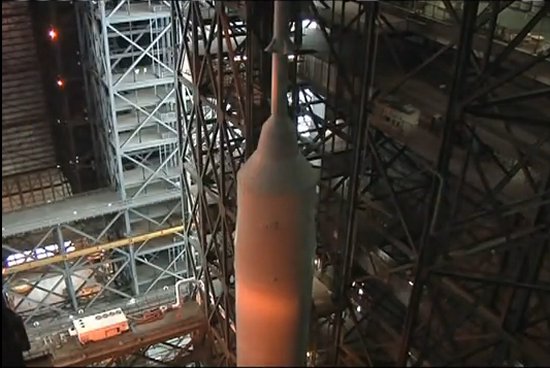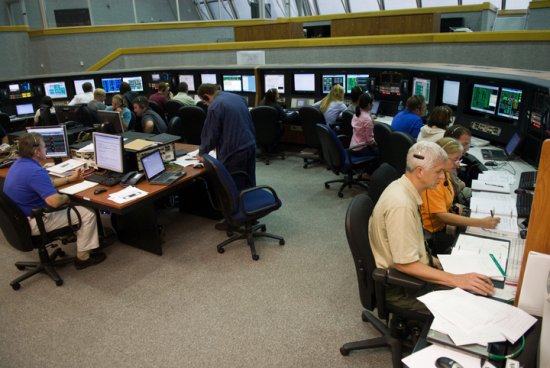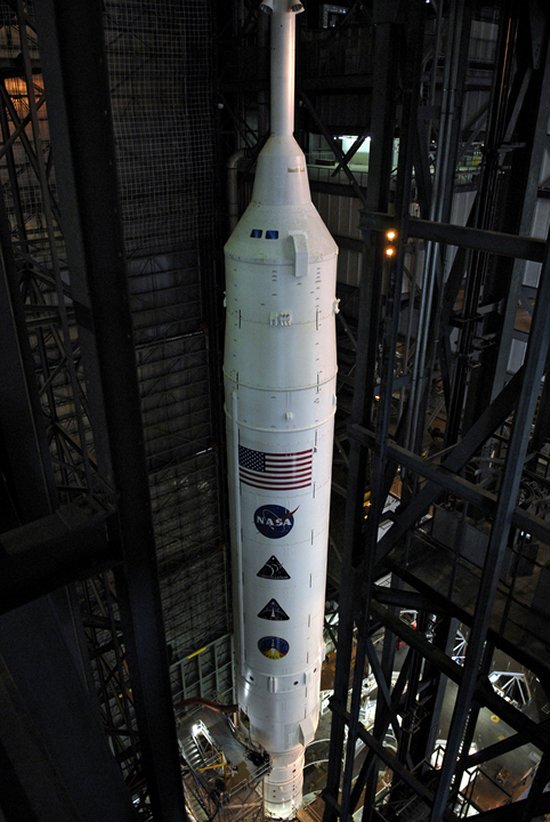During the months of the assembly operations, the Ares I-X team stuck a camera in the Vehicle Assembly Building to record everything.

The result…10 months of hard work stuffed into 5 minutes and 45 seconds. Watch the video on YouTube

Enjoy!!
During the months of the assembly operations, the Ares I-X team stuck a camera in the Vehicle Assembly Building to record everything.

The result…10 months of hard work stuffed into 5 minutes and 45 seconds. Watch the video on YouTube

Enjoy!!
The Ares I-X Launch Team spent the day in the firing room preparing for the upcoming launch. The team conducted a simulation of the last 50 minutes in the launch countdown.


Now this is no walk in the park simulation. The team was thrown different scenarios and issues that could come up during the actual launch countdown, including issues that could ultimately cause a launch delay. In fact, this specific set of simulations was focused on problems that the sim (simulation) team knew would prevent a launch in order to give the I-X launch team practice on handling emergency and stressful situations. All of this is designed to identify any problems in the countdown planning process and any vague areas in the launch commit criteria while stressing the team beyond what we ever expect to see on a real launch day. Sounds like fun, huh?

The simulation required support from Kennedy’s Firing Room 1, Cape Canaveral Air Force Station’s Hangar AE, the Software Integration Lab, or SIL, and team members from multiple NASA Centers. This was the first simulation with the entire team. The next simulation is planned for the end of September and will include the Launch Advisory Management Team.

Even though the rocket is now stacked and sitting on the mobile launch platform in Kennedy Space Center’s VAB, there is still a lot of testing and prep work to be done before it’s ready to roll out to the pad. Over the weekend (Aug. 29-30) the rocket underwent two days of modal testing to make sure it’s ready to stand up to the environments it’s about to find itself in.

The testing required a total of 44 accelerometers — a device that measures movement — to be installed on the flight test vehicle. And to put those on the vehicle it took more than 27,000 feet of cable. That’s more than 5 miles!

During the testing, vibrations were mechanically introduced into the rocket by four hydraulic shakers simulating the same kind of vibrations expected during flight so the effects could be monitored. A sway of the vehicle was then manually introduced (with a little help from Mission Manager, Bob Ess and Deputy Mission Manager Steve Davis) to create a lateral, back and forth motion so the team could measure how the rocket reacts.

Here’s a little fast-motion clip of Steve and Bob rocking the rocket (Flickr).
This part of the testing was important because it simulated the conditions the rocket could experience as it rolls out to Kennedy’s Launch Pad 39B, the wind conditions at the launch pad before it launches, and what it would experience during flight at first stage ignition.
NASA did some similar testing years ago on the Saturn V at Kennedy Space Center in the 60s. For those tests a group of people sat up on a platform and rocked the vehicle back and forth with their sneakered feet from one side, while another group of people pulled on the rocket with ropes from the other side. The group appropriately named it the “Tennis Shoe Test.”
The completion of the Ares I-X modal testing is an important step for the mission because it clears the way for next week’s Integrated Vehicle Power Application or systems power up test, which will be the first time that all of the electrical systems, control boxes and sensors will be turned on together and powered up.

Now this is something you’ve really got to see!
For the first time in more than 25 years, a new space vehicle is assembled and rarin’ to go in KSC’s Vehicle Assembly Building. Standing more than 320 feet tall, the rocket is almost twice as tall as a shuttle stack.

A crane hoisted the simulator launch abort system tower off the floor and placed it on top of the Ares I-X to complete he rocket stack.

It’s obviously a huge milestone! Now you can really get a feel for the scope of the vehicle.

The test rocket has been assembled on the top of a modified mobile launcher that used to be used by the shuttle.

Now that it is assembled, there will be extensive tests run on all the systems, including the set of complex instruments that will measure the rocket’s movements as it launches and the first stage separates.
These tests will include a process called “modal testing,” which will shake the stack slightly to test stiffness of the rocket including the pinned and bolted joints and make sure the rocket can handle the strain of launch and ascent. While those tests are conducted, a team of about 30 launch controllers also will practice their roles in the firing room preparing for its targeted launch in late October.

Yesterday, yet another portion of the Ares I-X rocket was stacked on the Mobile Launch Platform in Kennedy’s Vehicle Assembly Building. Now that super stack 1 is up and on, the 327-foot rocket is more than half way assembled and the team is getting excited as they watch it take shape in High Bay 3.

Super stack 1 is composed of the fifth segment simulator, forward skirt, forward skirt extension, frustum and interstages 1 and 2. It also includes two internal elements – the roll control system and the first stage avionics module – as well as the parachute system housed in the forward skirt extension. The team used a massive overhead crane, specially adapted for I-X use, to place it on top of the forward motor segment.

Over the next month, four more super stacks with the final pieces of hardware (including the simulated crew module and launch abort system) will be mated, finishing off the stacking operations for the rocket. So, in about a month, NASA is going to be able to show off one of the biggest rockets the world has ever seen!

Ares I-X is scheduled to roll out to launch complex 39B just four days prior to its targeted liftoff of October 31.

With its telltale “Z” stripe showing, the aft center section of the Ares I-X first stage booster is hoisted into place. Using a 325-ton capacity crane, the aft center is being lifted so it can be joined to the aft section already in place on mobile launch platform 1.

Last week the aft section was placed on MLP 1 and locked down by four huge bolts — each of which has 750,000 pounds of tension in them when torqued down. The 100 foot horizontal and 90 foot vertical journey from the center transfer aisle of the VAB into VAB high bay 3 takes many hours due to the methodical nature of handling and moving solid rocket motor segments loaded with hundreds of tons of explosive propellant.

Once the aft center section is in place, the forward center section will soon be brought over and finally the forward section will be joined to the other three. Once we have all 4 sections stacked, we will be ready for the first non-rocket motor section called Super Stack 1.






It may be pretty obvious, but it’s worth noting that one of the main purposes of a flight test is to do a little trailblazing. We can and should test processes and procedures as early in a program as possible so we can identify any areas for concern and target problem spots that need some improvement. The more we build and fly, the more we learn. As a flight test, Ares I-X is doing that exact thing for the Ares I rocket.
One aspect of rocket building that we are paying special attention to lately is vibration. Rockets vibrate a lot. In the case of Ares I-X, the vibrations come from several sources. Among them are the vibration and sound waves caused by the lift off of the rocket, the burning of rocket propellant and the act of plowing through the atmosphere at over four times the speed of sound.
The vibration that is produced by the burning of the solid rocket propellant in the first stage booster is called thrust oscillation. These vibrations — or oscillations — come in the form of waves, which travel up and down the length of the rocket like a musical note through an organ pipe. One of the biggest challenges in any rocket design is developing avionics (aviation electronics) that can function in this vibrating environment.
Vibration is not just a rocket issue, though. All electronic hardware is tested for its ability to handle shock and vibration. An MP3 player, for example, has to be tested for its ability to handle the vibrations from someone walking or jogging while holding it, placing it on a countertop, or accidentally dropping it on the floor. However, compared to the workout that Ares I-X’s avionics receive, your MP3 player has got it easy. Imagine shaking that MP3 player inside an automatic paint can shaker for two minutes while continuing to play your favorite tunes. That’s kind of what the electronics of the I-X are up against.
Two of the most important sets of electronics on Ares I-X are the thrust vector control (TVC) system, which steers the rocket, and the flight termination system (FTS), which is used to “self destruct” the rocket if it veers off its proper flight path.
Recently, NASA engineers at Langley Research Center upgraded to a new, higher-precision computer model, which allowed them to more closely examine the vibration environments on Ares I-X. With this more precise model, they observed that some areas of the rocket had vibration levels — called “G-loads” or just “loads” in engineer-speak — that were slightly higher than the levels the TVC and FTS were initially tested to handle.
How much is “slightly?” Well, Langley’s engineers are still examining the computer models to get the full answer, but right now the observed vibration levels are measured in hundredths of a gravity (or “G”). That would be like giving the automatic paint shaker one extra shake every minute — you wouldn’t notice the difference, but your MP3 player might.
The computer models have found that the biggest effects of the thrust oscillation on Ares I-X come between 70 and 90 seconds into the flight, when the rocket is about three fourths of the way through its ascent. Before 70 seconds and after 90 seconds the vibration levels are fine, but for those 20 seconds we haven’t fully verified that we can still steer the rocket with the TVC or send the signal to self-destruct the rocket and end the flight with the FTS if it veers away from its projected path.
So that’s the challenge the Ares I-X team is facing right now. Fortunately, we have several options for handling the situation, and the I-X team is looking at all of them to determine the best way forward:
Since the beginning of the I-X mission, NASA has worked very closely with the Air Force’s 45th Space Wing’s Range Safety team, which controls the range at Kennedy Space Center to make sure that every precaution is taken to ensure a safe launch and a safe flight. The 45th Space Wing will continue to work alongside the I-X team to evaluate the situation and make sure that the best decision is made.
The bottom line is that we’re not launching anything until it’s deemed safe by NASA and the U.S. Air Force, even if it takes a little longer to get it right. We’re all excited about watching Ares I-X take flight later this year, but really, we might end up learning just as much from these steps along the way as we do on launch day.
![]()

![]()
![]()
The Super Stack 1 assembly is now complete with the mating (stacking) of the forward assembly to the fifth segment simulator. Stack one is made up of eight individual pieces: interstages 1 and 2, the frustum, the forward skirt extension, the forward skirt and the aft, center and forward segments of the fifth segment simulator. It also includes two internal elements, the roll control system and the first stage avionics module.
All five super stack assemblies are now complete in High Bay 4 of the VAB and are ready for stacking on the mobile launcher platform in High Bay 3 later this month.

Just so you know, the reason the rocket is separated into these super stacks has to do with the height and weight of each piece for crane loads during lifting operations.
Super Stack 2: Upper Stage Simulator “Tuna Cans” segment 1
Super Stack 3: Upper Stage Simulator “Tuna Cans” segments 2, 3, 4, 5
Super Stack 4: Upper Stage Simulator “Tuna Cans” segments, 6, 7
Super Stack 5: Spacecraft Adapter, Service Module, Crew Module and Launch Abort System
Stacking is set to begin for the Ares I-X vehicle on Wednesday, July 8 in the Vehicle Assembly Building at Kennedy Space Center. It’s been a long time since the workers in the VAB have seen a new vehicle. In fact, it’s been 25 years since a new vehicle was stacked.
Following nearly three years of work by thousands of dedicated team members, the Ares I-X vehicle is ready for stacking on the Mobile Launch Platform, or MLP, in the Vehicle Assembly Building at Kennedy Space Center.
Over the last week, the management team has met for reviews. Today, a “go” was given for the stacking operations. All of the modification work has been completed in VAB High Bay 3, as well as the Mobile Launch Platform, in preparation for the new Ares I-X vehicle.
Tomorrow, the Ares I-X aft assembly, composed of the aft skirt and aft motor segment, will be rolled from the Rotation Processing and Surge Facility to the VAB and lifted by overhead crane and placed on the MLP. (Be sure to check out the KSC gallery for photo updates.)
Over the next month, the stacking operations will continue with the additional motor segments, simulated upper stage segments and the vehicle will be completed when the simulated crew module and launch abort system is added to the top. (There will be a time-lapse camera. NASA will be posting video and images.)
We will keep you posted on this blog, on our Facebook page and Twitter.
Let the stacking begin!
 From the Ares I-X mission manager perspective, this is a very exciting time for Ares I-X. All of our hardware is at Kennedy and is being prepared for stacking and launch. Facilities are being modified to accept the vehicle and support it at the launch pad. I can walk right from my office to where all this work is going on and talk to the people that are doing it, and check on progress every day. We are currently performing testing of our instrumentation on the vehicle to ensure that it is working prior to stacking of our hardware into “stacks.” Once the 5 stacks are completed later this summer, we will start assembling those stacks on top of each other in High Bay 3 of the Vehicle Assembly Building.
From the Ares I-X mission manager perspective, this is a very exciting time for Ares I-X. All of our hardware is at Kennedy and is being prepared for stacking and launch. Facilities are being modified to accept the vehicle and support it at the launch pad. I can walk right from my office to where all this work is going on and talk to the people that are doing it, and check on progress every day. We are currently performing testing of our instrumentation on the vehicle to ensure that it is working prior to stacking of our hardware into “stacks.” Once the 5 stacks are completed later this summer, we will start assembling those stacks on top of each other in High Bay 3 of the Vehicle Assembly Building.
Speaking of the people, our team has been doing an amazing job working through the challenges that inevitably come up during a test flight. We are all proud to set the stage for the future in many ways and to be participating in this one of a kind mission.
More to come…